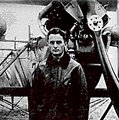Veterans' Memorial Project
Townsend Foster Dodd
Anna, IL

World War I
Colonel Dodd was appointed 2nd Lieutenant in the Coast Artillery Corps on 9/25/1909. He was transferred to the Aviation Section, Signal Corps in 1912. On 2/13/1913 he established a non-stop duration of flight record by flying 244.18 miles in 4 hours, 43 minutes in aircraft SC 26, a Burgess H Model. He also won the Mackay Trophy in 1914. Dodd was ordered to join the 1st Aero Squadron at Texas City, Texas, on 3/9/1913. He qualified as a Military Aviator 12/30/1913 and was one of the “original military aviators” listed in the War Department General Order #39, dated 5/27/1913. In June, 1913, he transferred with the 1st Aero Squadron to the San Diego Signal Corps Aviation School. There, he participated in various experiments and on boards to establish training requirements and aircraft specifications. Dodd went with the 1st Aero to Galveston during the Vera Cruz incident in 1914, then to Fort Sill. Shortly after the Squadron moved to Fort Sam Houston, Dodd participated with Captain Benjamin D. Foulois on the first tactical reconnaissance over hostile territory in Air Service history on 3/15/1916 with Pershing’s Punitive Expedition into Mexico.** He was selected by General Pershing as Aviation Officer of the American Expeditionary Force in 1917 and was appointed Lieutenant Colonel in the Signal Corps. He was superceded in that job by Colonel William Mitchell who outranked him. Dodd served as Chief of Materiel and Assistant Chief of Supply, Air Service, then as G-2, Air Service, First Army. He was promoted to Colonel 8/14/1918. Reverting to his pre-war rank of Captain, Dodd was serving as Commander of Langley Field when he was killed in an air crash on 10/5/1919 at Bustleton Field, Philadephia, while participating in the New York to Los Angeles transcontinental air race. On May 10, 1928, Dodd Field was designated in War Department General Order Number 5. It was named in honor of Colonel Dodd who had previously served at the field and had been commander of the Aviation Post when the 3rd Aero Squadron was stationed there. Active flight operations were terminated in October, 1931, and official date of closure of Dodd Field as an aviation facility has not been determined. More details about Dodd Field are available at the Web site listed above.
**7 Apr 1916–One of the interesting experiences was in connection with the obtaining of supplies from the city of Chihauhua. Chihuahua was held by the friendly forces of Carranza. Early one morning, two planes left San Geronomo for Chihauhua, for the purpose of obtaining the latest information and to arrange for the sending of supplies by rail from Chihuahua to San Antonio. One plane landed northwest of town, while the other landed on the east side. The observer from the first plane [handwritten: Dodd] commandeered a carriage and was driven to the American consulate. Merchants were called in and such supplies as were available were purchased and arrangements made for their being loaded so as to leave on a military train that was to depart for San Antonio that day at noon. During the negotiations, foreigners called up several times to inform the consul that an American officer was being taken down Liberty Street, to jail. This prisoner was Captain (later Brigadier General) B.D. Foulois. The supplies being loaded, at 11:00 a.m, the American consulate, accompanied by the aviator who had arranged for same, called upon the civilian governor of the state. The aviator was surprised and greatly pleased to find that the civilian governor had been a schoolmate of his at the University of Illinois. In company with the civilian governor, the Americans then called upon the military governor, who apologized profusely because Captain Foulois had been imprisoned. Captain Foulois had been released as soon as the Chief of Staff had been notified of his predicament and in company with the Chief of Staff, had gone to the landing field on the northwest side of town to post a guard of Mexican troops over the two planes (Foulois’s plane having flown over and joined the other after Foulois had landed.) That afternoon, Carberry, Dargue, and the Mexican soldiers of the guard repaired the damaged plane, while Captains Foulois and Dodd accepted the hospitality of the governor. Next morning, about 4 a.m., the party left the American consulate and after stopping for the military governor who wished to see the “take-off,” proceeded by car to the planes. After getting into the air, Carberry and Dodd flew over the city from southeast to northwest to see whether Dargue and Foulois had gotten away safely. Dargue’s machine had passed over the city on its homeward journey about a half hour before and had attracted the attention of the Mexicans, who then prepared to salute the other ship when it passed over. As Carberry’s ship flew over the city, at an altitude of 1,500 feet, it was received with a magnificent salute, caused by the discharge of hundreds of rifles from the housetops. The only uncomfortable part about this demonstration was that the rifles were loaded with ball cartridges and were aimed at the machine. Luckily, no damage was done and the airplanes returned safely to the American camp. (Townsend F. Dodd, the First United States Aero Squadron: Mexican Adventures of Foulois, Carberry, Kilner and Gorrell, 1919, U.S. Air Service [a magazine or newsletter], from BDF’s papers in the USAF Academy Library, p. 18)
– submitted by Mr. James Dodd, great-great-grandnephew; with additional information from Douglas S. Files, researcher and U.S. Air Force officer working on a book regarding early U.S. military aviation;
Submit additional information or comments
